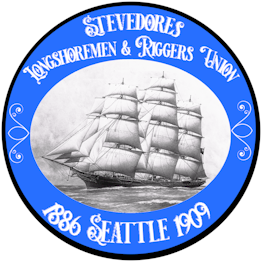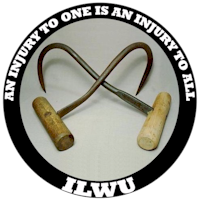
Seattle Waterfront History

Seattle Waterfront History
Longshoreman's Strike of 1886
It was a clear March day in 1886 and Mt. Rainier, glistening white with winter snow, loomed high over the small port of Tacoma. Rolling hills, thick-grown with tall Douglas fir, surrounded the port. The future of the trees was foretold in sawmill smoke and lumber stacks on flat wharves dotting the shoreline of Commencement Bay.
Tall mast sailing ships and steam schooners rocked softly against the wharves. White-plumed locomotives chugged busily along tracks skirting planked pilings. Horse-drawn carts meandered slowly along dirt roads leading south to New Town and north to Old Town, where the sawmills were located.
The Old Town docks were strangely quiet that Thursday, March 25, 1886. On a normal day, men would have been at work counting boards and stacking the exact number of each size in separate piles. These, stacks would then be dragged by horses to skids set at the stern of the ships. Other longshoremen would have been hauling lumber up skids to the ship hatches.
There the men would have been carrying each board piece-by-piece to the forward hold and stacking the lumber into tiers. But the docks were deserted the longshoremen were on strike! When work stopped at the Tacoma Mill Company wharf on March 22, 1886, the first indication of trouble reached City Hall in a message from the dock employers to Mayor R. Jacob Weisbach. The owners reported, "A mob in charge of our wharf will not allow our men to work. Can you give us protection? "
Weisbach sent a message to the Old Town deputy marshal asking for a report. The marshal reported that an Indian had tried to continue working at the standard 30cts an hour rate, but was stopped by the strikers. All is quiet now, concluded the deputy's report. Realizing the strikers' determination, the stevedoring firm dispatched the steamer Biz to Seattle to hire strikebreakers. Strikers responded by sending telegrams to every port on Puget Sound telling other longshoremen to stay away from Tacoma.
On Thursday, March 25, the Tacoma Daily Ledger reported;
Messrs. C. Renck J Matson and M. Doulton, the committee representing the strikers said, in an interview with a Ledger reporter, that the first of the trouble commenced last week when Captain Libby, Senior, spoke to one of the men working on the wharf, who was smoking, and told him if he did not take his pipe out of his mouth that he must put on his coat and leave off work. The employee at once complied and ceased work. Subsequently the longshoremen held a meeting and decided to strike for an increase of 10cts an hour.
In answer to a question the committee said that, although the present rate of work is $18 a week the average pay of the men all the year round is $9, the time for which they are employed not averaging three days a week. The number of men who actually struck on Monday morning was forty and some fifty others who were waiting for employment immediately joined and declined to work unless at the advance rate.
The striking longshoremen held out for five days. No strikebreakers appeared, and no one tried to work. No foreign ships loaded lumber or sailed from the Tacoma Mill Company wharf. The strikers held mass meetings and swore that they would form their own stevedoring company to handle the contract currently held by DeLion and Company of Port Townsend. Sensing the urgency of the situation, J. B. Libby, the local DeLion representative, called in Captain R. W DeLion to negotiate with the strikers.
At the same time DeLion was meeting with disgruntled workers, strikers were joining the new Stevedores, Longshoremen and Riggers' Union of Puget Sound as quickly as they could get membership cards. Thus, DeLion had little choice but to grant wage increases if he wanted his lumber put on the ships. At noon, March 26, 1886, the men went back to work, richer by ten cents an hour, and members of their own union. It was an auspicious beginning to the long and eventful history of workers on Tacoma's waterfront.
1878 Newspaper Advertisement
Seattle Stevedore Society 1882
